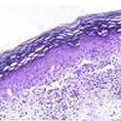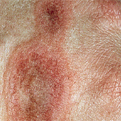Erythema Multiforme
General Information
Erythema Multiforme is a type of hypersensitivity (allergic) reaction that occurs when certain medications are taken, with infections, or illness. Medications associated with erythema multiforme include sulfonamides, penicillins, barbiturates, and phenytoin. Blood vessels are damaged in the disorder that then causes subsequent damage to the skin tissue. Treatment goals include control of the underlying causes or illnesses, treatment of the symptoms, and prevention of infection. Medication that causes the reaction should be discontinued. Treatment for mild cases include moist compresses applied to skin lesions; antihistamines to control itching; medications to reduce fever and discomfort; Topical anesthetics (especially for mouth lesions) to ease discomfort that interferes with eating and drinking. Treatments for severe cases include hospitalization and treatment in an intensive care or burn care unit; Systemic corticosteroids to control inflammation; Intravenous immunoglobulins (IVIG) to stop the process; Antibiotics to control secondary skin infections.
Epidemiology
Estimated to be between 0.01 and 1%, primarily in young adults and children
Etiology
Not completely understood but appears to involve a hypersensitivity reaction that can be triggered by a variety of stimuli, particularly bacterial, viral, or chemical products.
Pathogenesis
Sudden onset of rapidly progressive, symmetrical, and cutaneous and/or mucocutaneous lesions, with concentric color changes in some or all lesions; centripetal spread; burning sensation in affected areas; pruritus generally absent.
Clinical
Symmetrically distributed, erythematous, expanding macules or papules evolve into classic iris or target lesions, with bright red borders and central petechiae, vesicles, or purpura.
Histology
Lymphocytic infiltrate at the dermal-epidermal junction and around dermal blood vessels, dermal edema, epidermal keratinocyte necrosis, and subepidermal bullae formation.
Bibliography
1. “Erythema multiforme” (Online) October 2006. http://www.nlm.nih.gov/medlineplus/ency/article/000851.htm (visited: March 17, 2008) 2. “Erythema Multiforme” (Online). June 2006. http://www.emedicine.com/emerg/topic173.htm (visited: March 17, 2008)
Download PDF
![]() Erythema Multiforme
Erythema Multiforme


